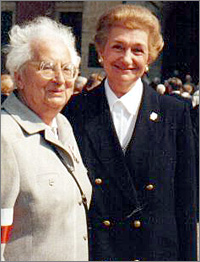
part 1 2 3 4
The head of the SS, Heinrich Himmler, had ordered the mobilisation of a special division under the command of notorious Erich Von den Bach. So, at the same time as the Zoska battalion was liberating the Jews, Von den Bach's men were launching a full scale attack on the "Vola" district in the western suburbs.
Maria Jaszczol lived in the Wola district of Warsaw with her family. Her father was killed by the S.S. in the civilian massacre of August 5, 1944.
"Germans ask all the civilians from all the block of flats to come down to the street," remembers Jaszczol, "and it didn't matter whether it was small children or grown-up parents or old people, they all had to come. They heard machine gun shots. When these machine guns were getting nearer and nearer, my younger brother sort of tried to shield my father. Well, the German took him by the back of his neck and throw him to the ground and shot my father. Not only him, all the other people as well. Thousands of people were killed, more than 20, if not more in that one day, in those few hours. We did not realise that they are not only shooting the people, that they not only burned the houses but also the human bodies. Even if some of them were still alive, they just burned everything. Next day - so that was the sixth, August - we couldn't breathe because, although it was a beautiful sunny day, it was complete darkness. The smoke was so dense."
An estimated 35,000 people were shot by the SS in Warsaw that day, but in other parts of the city, in the Old Town for instance, people were unaware of the massacre. Each district of Warsaw had become a fortress almost totally separated from its neighbour by barricades and enemy lines.
"At one stage," says Jaszczol, "I went to the old town. They were celebrating because they already managed to liberate this old town, so they were singing and dancing. They didn't know what went on in Vola. They didn't. We were young. We were very young. Between the age of 16 and 20, 22, and we were full of life and full of energy and we were uplifted by the fact that we are doing something, that we are fighting for our freedom. There were times when we were dancing if we get the chance or singing, or joking with each other. I think that, that was the part of us which wanted to live."
On day 13, the fighters in the Old Town captured yet another tank, but this time, it was not accompanied by singing and dancing.
|  | | Hanna Niedzielska-Kepinska (right) |
"I was in the gatekeeper's flat and in his kitchen," recalls Hanna Niedzielska-Kepinska, "and I was preparing soup for the boys which were fighting on the barricades, and suddenly my colleague came to me and said, 'Hanna, come, come because our boys brought the tank. It's outside our gate.' So I said, 'Alright. I will come, I will come, I have to finish the soup.'"
In a recording from the Imperial War Museum archive, Zofia Nowiak says "We were standing on the balcony. I have seen the little tank coming towards us and on this tank there was a little boy with a little Polish flag on the top. There were quite a lot of people around him and everybody was singing and shouting because this tank was moving and the Polish crew was in it."
"The tank was packed with explosives and they were timed," says Hanna Niedzielska-Kepinska.
"There was such a terrible explosion and when we looked down," says Nowiak, "all the square was littered with the bodies."
"On the street, when I went out finally from the house," says Niedzielska-Kepinska, "it was so slippery because it was the remnants, blood, everything mixed together. It was a carnage."
"There was dead silence for a while," says Nowiak. "And then, suddenly, they started to cry and scream, and that was the beginning of the hell."
Go to part 4
|

